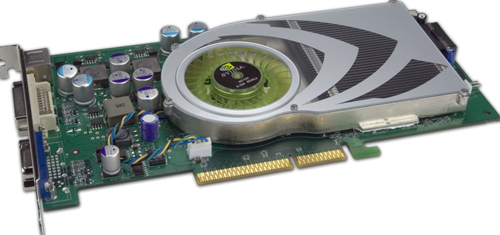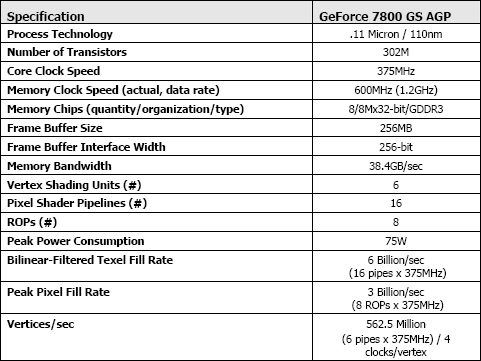The Card and The Test
As mentioned, we currently have both a 7800 GS from EVGA and the 7800 GS OC from BFG. Neither of these cards run at the default 375/1.2 clock speeds set forth by NVIDIA. For the purposes of these tests, we underclocked a card to the minimum speed that NVIDIA is endorsing. With the high clock speeds that we see from BFG and EVGA, we'd be willing to bet that even 7800 GS parts that don't come factory overclocked would have some head room. The EVGA card is clocked at core/mem clocks of 460/1.35, while the BFG part runs at 400/1.25. It is interesting to note that the BFG part makes a bigger deal out of being overclocked on the box than the EVGA card, but either way, the 7800 GS is no slouch.
Gigabyte K8U-939 ULi based motherboard
AMD Athlon 64 FX-57
2x 1GB OCZ PC4000 RAM @ 200MHz 2:3:3:8
160GB Seagate 7200.7 HD
OCZ 600W PowerStream PSU
For reference, we have included the 7800 GTX 512 and the X1900 XTX. This gives us a clear look at the highest end ATI and NVIDIA hardware available for both the AGP and PCIe platforms. The 7800 GT is also included in order to show us the performance of the next fastest NVIDIA part out there.
Here's a breakdown of the 7800 GS specifications as outlined by NVIDIA.
As mentioned, we currently have both a 7800 GS from EVGA and the 7800 GS OC from BFG. Neither of these cards run at the default 375/1.2 clock speeds set forth by NVIDIA. For the purposes of these tests, we underclocked a card to the minimum speed that NVIDIA is endorsing. With the high clock speeds that we see from BFG and EVGA, we'd be willing to bet that even 7800 GS parts that don't come factory overclocked would have some head room. The EVGA card is clocked at core/mem clocks of 460/1.35, while the BFG part runs at 400/1.25. It is interesting to note that the BFG part makes a bigger deal out of being overclocked on the box than the EVGA card, but either way, the 7800 GS is no slouch.


Gigabyte K8U-939 ULi based motherboard
AMD Athlon 64 FX-57
2x 1GB OCZ PC4000 RAM @ 200MHz 2:3:3:8
160GB Seagate 7200.7 HD
OCZ 600W PowerStream PSU
For reference, we have included the 7800 GTX 512 and the X1900 XTX. This gives us a clear look at the highest end ATI and NVIDIA hardware available for both the AGP and PCIe platforms. The 7800 GT is also included in order to show us the performance of the next fastest NVIDIA part out there.
Here's a breakdown of the 7800 GS specifications as outlined by NVIDIA.











93 Comments
View All Comments
sandman74 - Thursday, February 2, 2006 - link
I hate to repeat what the others have said, but this review was borderline useless to the very people who would come here to find out how well the card performs...
My other half has a 6600GT, and I have a 9800 Pro. How does the 7800 GS compare as an upgrade. NO IDEA is the conclusion I reached after reading your review, which has forced me to look elsewhere.
I did however find the article interesting to see how it compared with PCI-E cards, but thats about it.
I think you need to add in some more cards to THIS review, rather than letting everyone wait for another AGP comparison in a few weeks time.
manno - Thursday, February 2, 2006 - link
Is everyone overlooking the fact that this is going to be a part with a $399 MSRP?, and why no 6800GT AGP, or 6800GS AGP(same thing) an ommision like that is preaty bad.spinportal - Thursday, February 2, 2006 - link
So far the guesses have been between 300 and 350 USD for a plain vanilla or OC part.coldpower27 - Thursday, February 2, 2006 - link
the MSRP of the 7800 GS AGP is indeed 349US, the OC parts are about MSRP 379US, however we will have to wait to see how this translate to street pricing.The X850 XT PCI-E/AGP is MSRP 499US, Street 200-250
The 7800 GT PCI-E is MSRP 449US Street 275-300
The 6800 GS PCI-E/AGP is MSRP 249US Street ~200
johnsonx - Thursday, February 2, 2006 - link
Someone from AT should probably say this, but perhaps they think it's obvious:This article is about the launch of the NVidia GeForce 7800GS GPU. It is NOT about a particular vendor's board. Vendor boards are tested in vendor roundups or occaisionally individual board reviews.
While I agree it would have been *interesting* to see the vendor cards tested at their shipping clock speeds, that is really for another article. A GPU launch article should test either reference hardware or vendor hardware set to reference clocks, and this article does exactly that. Period. Quit complaining.
People should also keep in mind that neither AT nor most other sites re-run every benchmark on every card for every test. They test the new card on their standard hardware platform using current benchmarks, and then use benchmark numbers for other cards from recent tests. Older cards were last tested on an older platform using older benchmarks, so no comparable benchmark numbers are available.
AT isn't going to re-benchmark a pile of older cards unless doing so is the POINT of the article. This article, again, is about the launch of a new GPU, not a 'Mid-range to High-end AGP Comparo' or '7800GS Vendor Roundup'.
spinportal - Thursday, February 2, 2006 - link
Then why doesn't AT just have a Video Chart that can pull similiar Min/Max/Avg FPS for each type of test at each resolution / AA / AF setting at-a-glance? Instead we have to muck around dozens of articles and have no generic yardstick. Why include the 7800GTX then if not to compare? Stop being an apologist.spinportal - Thursday, February 2, 2006 - link
Let me be more clear..Why can't AT build an result aggregator database / spreadsheet?
Cygni - Thursday, February 2, 2006 - link
Your kidding right? Ok 1) You do realize that more than one person does reviews for Anandtech. 2) Due to 1 (see above), it would be a weebit difficult to ship the standardized review rig to each persons house. 3) The tests done on games change over time. When 6800 Ultra's were being reviewed, there was a totally different set of games being played. 4) As with 3 (see above), hardware changes over time. If they wanted to test on the same system for every graphics card YEARS apart, they would still be using a 486.This isnt Toms. If you want the VGA Charts, go get them.
spinportal - Friday, February 3, 2006 - link
Im sure this being a *technical* site, one can factor in plain vanilla CPU/mobo/chipset and formulize those effects vs. the video card. I guess Futuremark's database is closer to where I'm going, where its a composite scoring system, and then an overall, but not divergant and possibly too specialized and even misses the market's techniques. Tom's chart is a bit fuzzy to read it makes my eyes blur at times ;) I mean I could try to scour thru AT and do my own chart in excel (and factor in platform %), but who has timeSharptooth - Thursday, February 2, 2006 - link
First, I enjoyed this review as it has relevance to me (NF2 AGP user). However, as already mentioned, it would help to compare this card to other AGP cards (6600GT, 6800GT/Ultra, X800XT/PE, X850XT/PE) because AGP systems use these cards. That way, it'll help to access any inherent value (if any) to purchasing. Also, while most reviewers have chosen A64 AGP systems, benchmarking on other platforms (like Socket A) would be extremely appreciated as many (including me) still use these systems.--Fernando